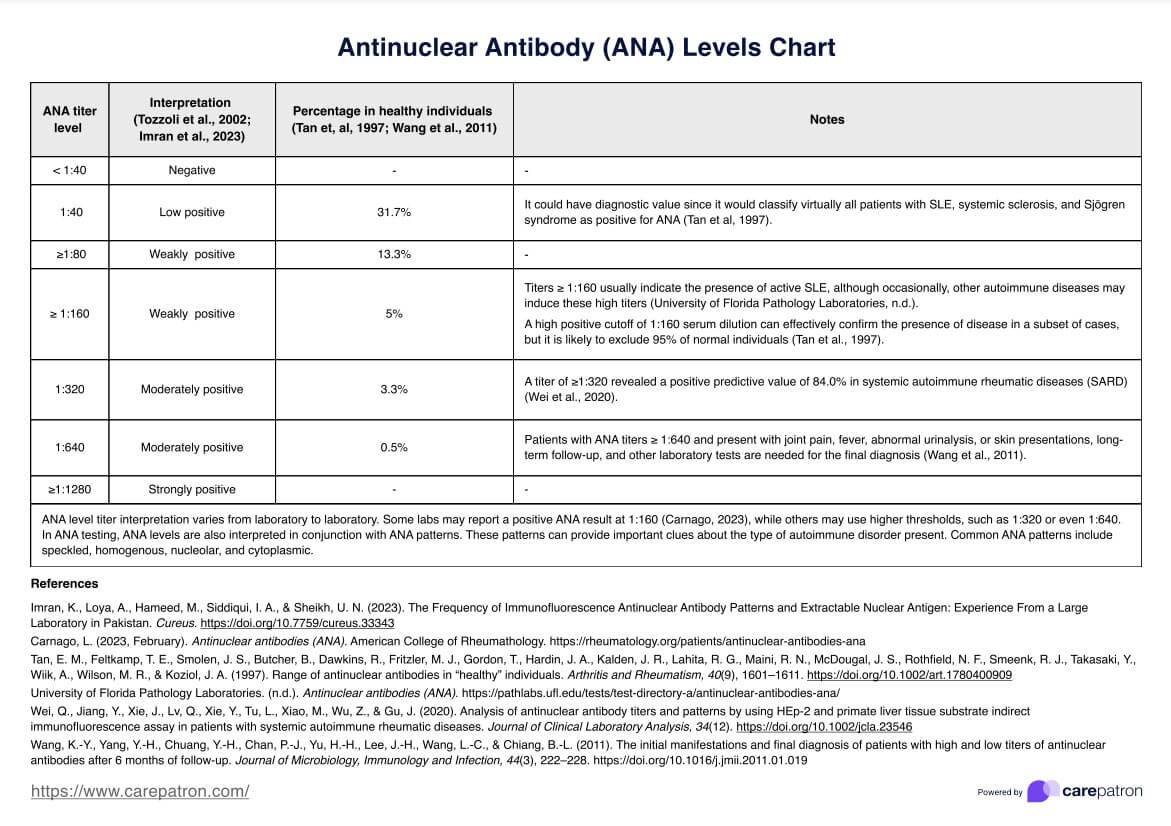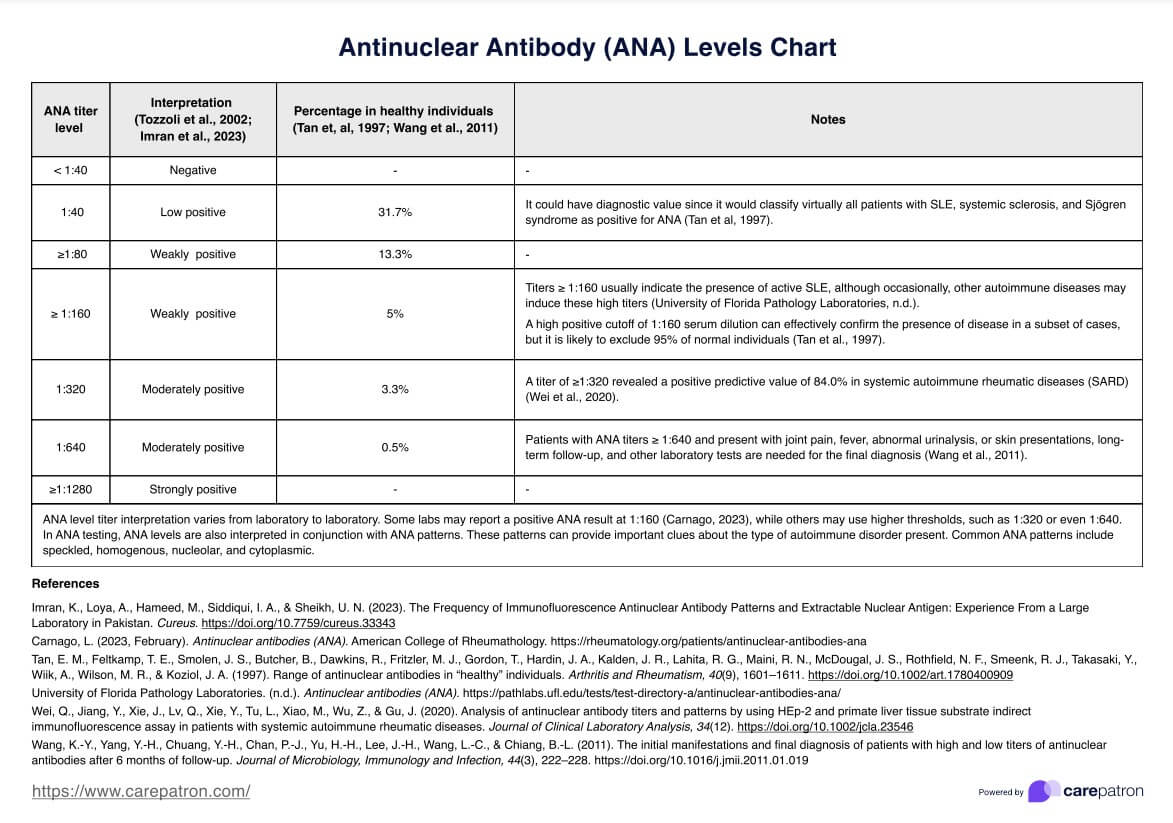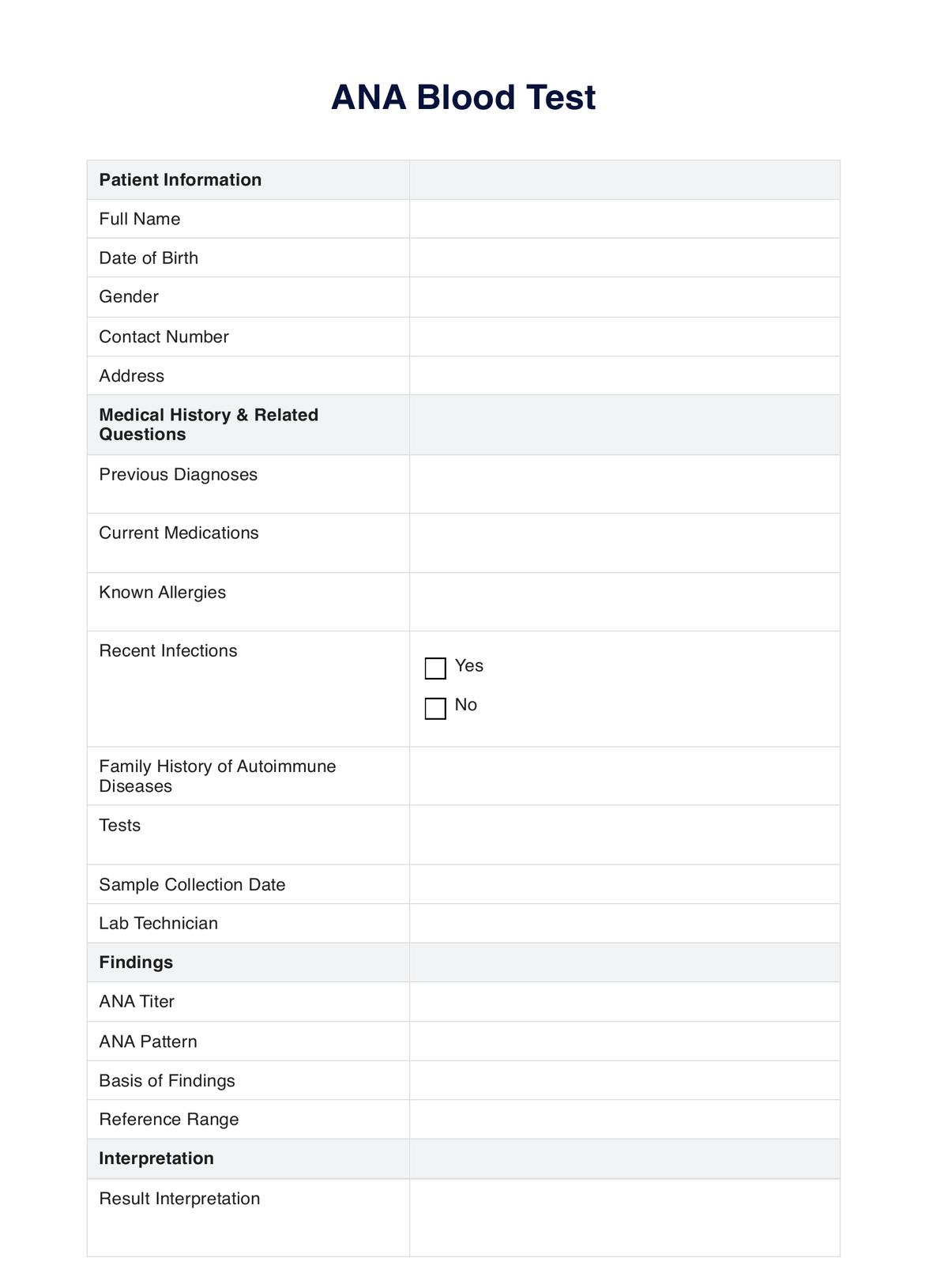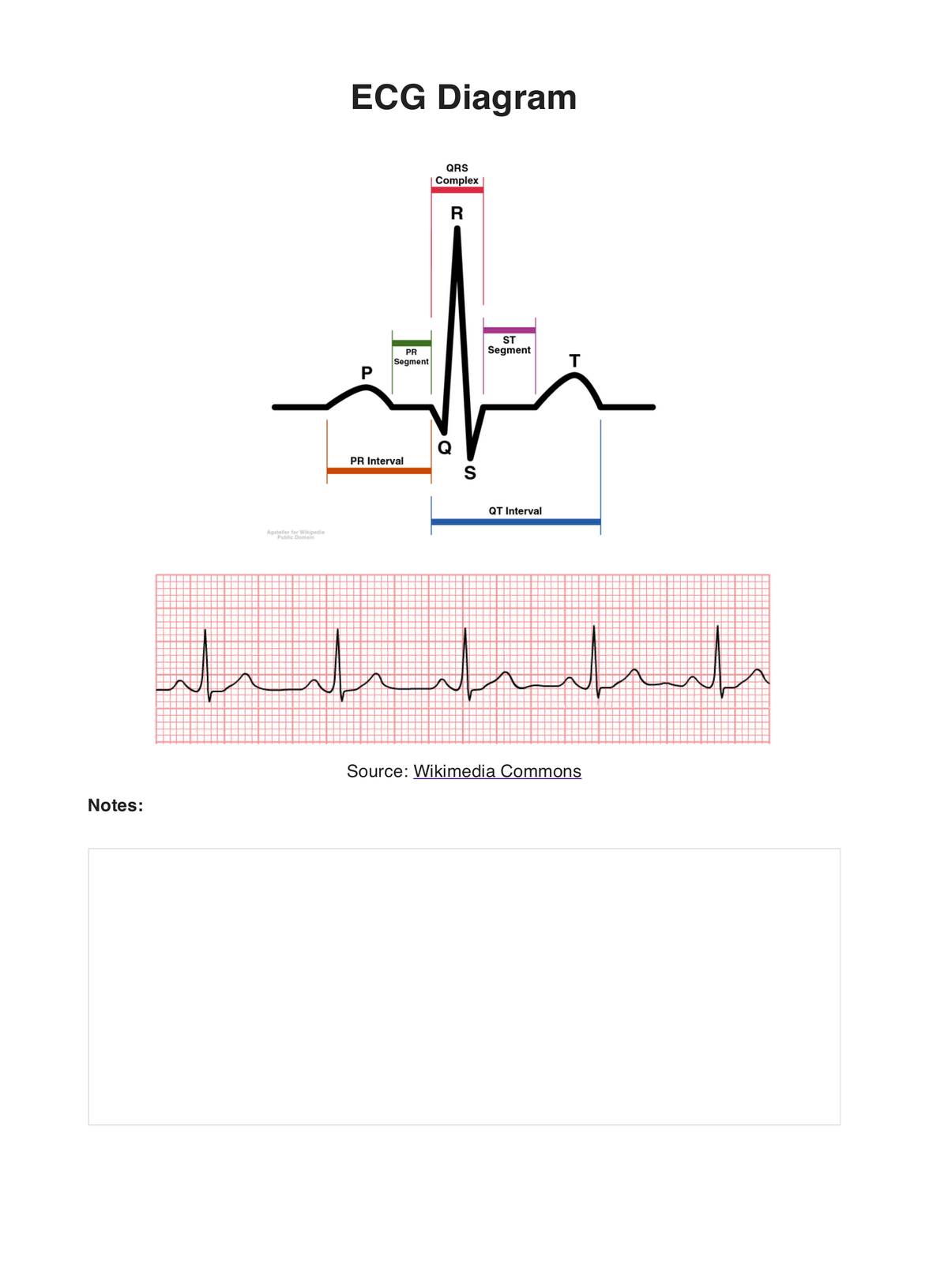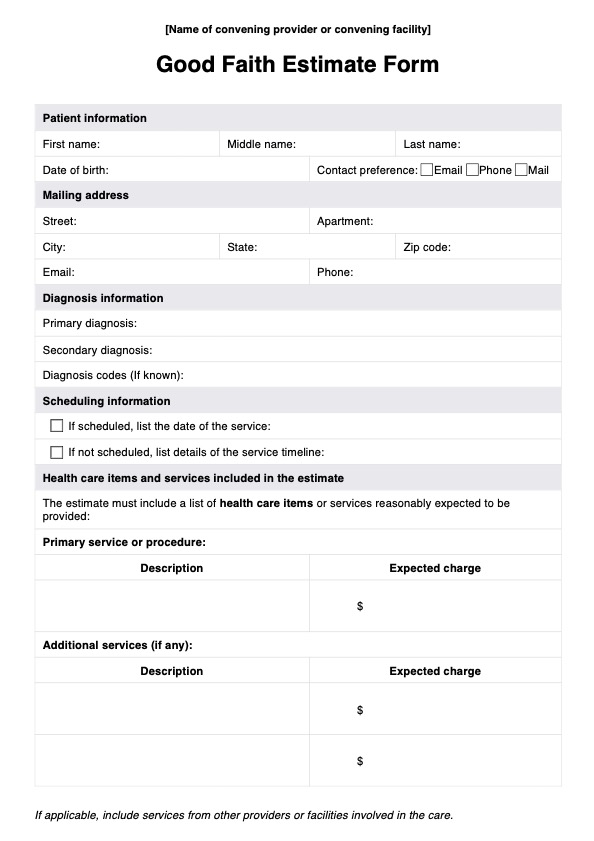ANA Levels Chart
Access a free ANA Levels Chart to make interpreting ANA test results easier. Get the PDF template here.


What is an ANA Levels Chart?
An antinuclear antibody (ANA) Levels Chart is a medical resource that provides general reference values that healthcare professionals can use to interpret the titer level results of a patient's ANA blood test.
An antinuclear antibody test detects antibodies that attack the body's own healthy tissues, but it's not a sure indication of autoimmune disease (Carnago, 2023). This initial screening test, along with other laboratory tests, the patient's medical history, and physical examination, helps healthcare professionals diagnose autoimmune diseases such as lupus, rheumatoid arthritis, and Sjögren's syndrome.
Our ANA Levels Chart includes ranges of ANA titers, which represent the concentration of these antibodies in the blood, as well as a brief interpretation for each level. However, it's important to note that interpretation for each ANA titer level varies from one laboratory to another. Some laboratories may consider a titer level of 1:60 or higher a highly positive result, while others may have different reference values.
In ANA tests, these titers should also be interpreted along with ANA patterns, which are visualized under a microscope. These patterns may indicate the type of autoimmune disease present in the patient. Common ANA patterns include speckled, homogeneous, and nucleolar.
ANA Levels Chart Template
ANA Levels Chart Example
How does this template work?
Carepatron's ANA Levels Chart is a comprehensive and user-friendly PDF document that can be downloaded for free. You can use it as a handout when interpreting ANA test results. However, note that this template does not include references for ANA patterns. Follow these steps to get started:
Step 1: Access the resource
Click "Use Template" to utilize the chart via the Carepatron app, allowing you to customize it for your needs. You can also choose "Download" for a PDF copy.
Step 2: Interpret ANA test results
Refer to the chart for the interpretation of titer levels as part of an ANA test. Note that the results and ANA level interpretations may vary depending on the laboratory and testing method used.
Step 3: Use in conjunction with the patient's symptoms and medical history
Use the ANA Levels Chart as a guide in evaluating the significance of ANA laboratory test results in relation to the patient's symptoms and medical history. This will help determine if further testing or treatment is needed.
Step 4: Save for future reference
You can save a copy of the chart for future reference, making it easily accessible whenever needed. This can also help you track any changes in ANA levels over time.
When would you use this chart?
The ANA Levels Chart is a valuable resource primarily utilized by healthcare practitioners, especially in rheumatology, immunology, and internal medicine. Here are scenarios when this chart proves to be particularly beneficial:
Suspected autoimmune disorder
An ANA Levels Chart is particularly useful as a reference when a person is suspected of having an autoimmune disorder. The chart can help you determine the likelihood of an autoimmune disorder based on the levels of antinuclear antibodies in a person's blood.
Assessing the significance of positive test results
Because ANA is also found in healthy individuals or in those with other autoimmune diseases, healthcare professionals rely on the chart and additional clinical information to determine whether the positive ANA test result is significant. For example, in cases of systemic lupus erythematosus, a positive ANA result is present in nearly all patients (Zanussi et al., 2023), but in other conditions like mixed connective tissue disease, the interpretation of the ANA test results may vary based on specific levels and patterns of antibodies or associated clinical symptoms.
An educational tool for patients
The ANA Levels Chart can also be used as an educational tool for patients who have undergone ANA testing. It can help them better understand their results and the significance of ANA levels in relation to their symptoms and medical history.
By providing patients with this information, healthcare professionals can empower them to be more involved in their own healthcare and make informed decisions about their treatment.
ANA levels and ANA patterns
As mentioned, while ANA levels are useful in determining the presence of ANA in the blood, they should be interpreted in conjunction with ANA patterns. Here are some common ANA patterns that healthcare professionals may encounter when analyzing ANA test results (University of Florida Pathology Laboratories, n.d.):
Smooth or homogenous
The smooth (homogeneous) ANA pattern is commonly associated with systemic lupus erythematosus (SLE), drug-induced lupus (DIL), and other collagen diseases like chronic active hepatitis and systemic scleroderma.
Speckled
The speckled ANA pattern is commonly associated with conditions such as SLE, Sjögren’s syndrome, mixed connective tissue disease, and rheumatoid arthritis (RA).
Nucleolar
The nucleolar ANA pattern is most frequently associated with progressive systemic sclerosis (PSS), also known as scleroderma, as well as Sjögren’s syndrome.
Centromere
The centromere ANA pattern is commonly linked to scleroderma and CREST syndrome. Diagnostic testing often involves SS-A/SS-B, Scl-70, and Anti-RNP antibodies.
References
Carnago, L. (2023, February). Antinuclear antibodies (ANA). American College of Rheumathology. https://rheumatology.org/patients/antinuclear-antibodies-ana
University of Florida Pathology Laboratories. (n.d.). Antinuclear antibodies (ANA). https://pathlabs.ufl.edu/tests/test-directory-a/antinuclear-antibodies-ana/
Zanussi, J. T., Zhao, J., Wei, W.-Q., Karakoc, G., Chung, C. P., Feng, Q., Olsen, N. J., Stein, C. M., & Kawai, V. K. (2023). Clinical diagnoses associated with a positive antinuclear antibody test in patients with and without autoimmune disease. BMC Rheumatology, 7, 24. https://doi.org/10.1186/s41927-023-00349-4
Commonly asked questions
There is no specific ANA level considered high, as it can vary depending on the lab and testing method used. A positive ANA test result is usually reported in titer levels and ANA patterns, which can range from 1:40 to 1:1280 or higher. A high ANA level may indicate the presence of autoimmune disease, but further testing and evaluation by a healthcare professional is necessary for diagnosis.
There is no specific ANA number that indicates lupus. A positive ANA test, along with other diagnostic criteria and symptoms, can lead to a diagnosis of lupus. It is important to note that a positive ANA test does not always indicate an autoimmune disease and may also be present in healthy individuals.
Healthcare professionals use ANA Levels Charts to interpret the results of ANA tests. The charts provide a visual representation of antibody levels and patterns, aiding in identifying specific autoimmune conditions and guiding treatment decisions.
The normal range for ANA results can vary depending on the lab and testing method used. A negative ANA test result is usually reported as less than 1:40. However, a positive ANA test result does not necessarily indicate the presence of an autoimmune disease, and further testing and evaluation by a healthcare professional is necessary for diagnosis.


